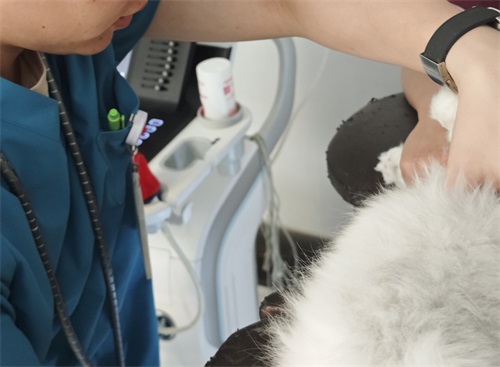In the ever-evolving field of veterinary medicine, few innovations have brought as much change as ultrasound technology. What was once a luxury reserved for advanced referral hospitals has now become a routine diagnostic tool across general practices, rural farms, and even wildlife conservation units. For the modern veterinarian, ultrasound is no longer just an imaging method—it is a decision-making powerhouse, transforming the accuracy, efficiency, and reach of veterinary care.

This article explores how ultrasound technology is reshaping the veterinarian’s role across diverse animal sectors. From livestock productivity to companion animal diagnostics, we’ll examine how this non-invasive tool empowers vets worldwide to provide better outcomes for animals and their owners.
A New Era of Veterinary Diagnostics
In traditional veterinary practice, diagnosing internal issues often required invasive procedures or depended on subtle external signs. With ultrasound, veterinarians can now look inside the body in real time—safely and painlessly.
Ultrasound works by sending high-frequency sound waves into the body and capturing echoes to create a visual representation of tissues and organs. This real-time feedback allows for immediate decisions, which is particularly useful in emergency cases, pregnancy checks, and internal organ evaluation.
In companion animal clinics across the United States, the United Kingdom, and Australia, for example, veterinarians use ultrasound to:
Detect internal bleeding after trauma
Evaluate heart function (echocardiography)
Identify liver, kidney, or bladder abnormalities
Diagnose gastrointestinal obstructions
Ultrasound has transitioned from a luxury to a necessity. A 2023 report by the British Small Animal Veterinary Association indicated that 68% of UK veterinary practices now have in-house ultrasound units, a significant jump from just a decade ago.
Revolutionizing Livestock Veterinary Medicine
Perhaps nowhere is the impact of ultrasound more transformative than in livestock medicine. Traditionally, assessing fertility, pregnancy, and growth in animals like cattle, pigs, and sheep relied on palpation, observation, or bloodwork—methods that were time-consuming, less accurate, or stressful for the animals.
Today, Veterinary ultrasound has changed that entirely.
Reproductive Management
On farms in the U.S. Midwest, Argentina, and parts of Europe, ultrasound is now the cornerstone of reproductive management in cattle and pigs. With real-time imaging, vets and farmers can:
Detect pregnancy as early as 25–30 days post-insemination
Determine fetal viability
Monitor uterine health after calving
Identify reproductive tract disorders such as cysts or infections
This has dramatically reduced the number of “empty” animals (non-pregnant but still consuming feed), improving herd efficiency and profitability.
Growth Monitoring and Carcass Quality
Ultrasound is also used to evaluate growth in young beef cattle. By measuring parameters such as eye muscle area (EMA) and backfat thickness, producers can identify ideal times for fattening or slaughter. This is especially relevant in commercial feedlots across North America and Australia.
For instance, using a B-mode ultrasound scanner, farmers can track:
Muscle development in the Longissimus dorsi region
Subcutaneous fat deposition at the rump or ribs
Intramuscular fat (marbling) levels, which influence meat quality
This real-time data enables targeted feeding programs, reduced feed waste, and improved carcass grading. As highlighted in a 2023 article by the Beef Cattle Institute, ultrasound growth evaluation has become standard practice on many high-performing cattle farms.
Enhancing Surgical and Emergency Capabilities
In emergency and surgical settings, ultrasound has added new layers of precision and confidence for veterinarians.
FAST Scanning
The Focused Assessment with Sonography for Trauma (FAST) scan, widely used in human medicine, is now commonplace in veterinary ERs. It allows vets to quickly detect internal bleeding, ruptured organs, or fluid accumulation.
Whether dealing with a dog hit by a car in California or a horse with colic in Germany, a portable ultrasound scanner helps vets make life-saving decisions in minutes.
Guided Procedures
Ultrasound guidance has also improved the success rate and safety of procedures such as:
Cystocentesis (bladder fluid aspiration)
Biopsies of internal organs
Pericardiocentesis (fluid removal from the sac around the heart)
Ultrasound allows for minimal invasiveness and lower complication rates, essential benefits in small animal and equine care alike.
Portable Ultrasound: Expanding the Vet’s Reach
One of the most important developments in veterinary ultrasound has been the miniaturization of devices. Modern portable scanners like the BXL-V50 have revolutionized how and where vets can provide care.
These handheld, battery-operated machines are now used:
In mobile clinics serving remote ranches in Texas or Alberta
In fieldwork involving wildlife monitoring in Africa or Asia
In equine medicine at racing tracks or stud farms
With high-resolution imaging and waterproof designs, such devices offer real-time scanning even in rugged environments. The BXL-V50, for instance, features an 8" HD screen and supports multi-species diagnostics, making it a go-to tool for mixed-animal practitioners worldwide.
Training and Global Adoption
As ultrasound becomes more accessible, veterinary schools globally have integrated it into their core training. In the U.S., schools like Colorado State University and the University of Florida offer hands-on ultrasound education in their first two years of the DVM program.
In developing countries, NGOs and veterinary outreach programs are now equipping local vets with basic ultrasound training to improve animal welfare. For instance, in parts of East Africa, ultrasound is used to track livestock pregnancy in nomadic herds—ensuring food security for pastoral communities.
This widespread adoption has been bolstered by the fact that ultrasound is:
Non-ionizing (unlike X-rays)
Cost-effective over time
Easy to learn with minimal risk to animals
Veterinary Ultrasound and Animal Welfare
Beyond diagnostics and productivity, ultrasound also enhances animal welfare—a major concern for today’s vets and animal owners.
By reducing the need for exploratory surgery or repeat invasive exams, ultrasound minimizes animal stress and recovery time. It also promotes earlier intervention, which leads to better outcomes and less suffering.
For instance, early detection of uterine infections in dairy cows can prevent systemic illness. Diagnosing bladder stones in cats via ultrasound avoids the need for painful catheterization or guesswork.
Globally, this aligns with the One Health approach, recognizing that animal welfare, human health, and environmental stability are interlinked.
The Future of Veterinary Ultrasound
With advances in AI and wireless technology, the future of ultrasound in veterinary medicine looks even more promising.
Developments currently underway include:
AI-assisted diagnosis: Algorithms can already identify pregnancy stages or organ abnormalities.
Cloud storage and telemedicine: Vets can share images with specialists remotely, speeding up second opinions.
Wireless probes: Cutting cords enhances mobility, especially in field applications.
As hardware becomes more affordable and software more intuitive, even small clinics in remote areas will be able to offer high-level diagnostic services.
Conclusion
Ultrasound technology has undeniably transformed the veterinary profession. No longer limited to specialized practices, it now empowers vets in rural farms, urban clinics, and wildlife parks alike to deliver faster, safer, and smarter care.
From guiding life-saving procedures to improving food production and animal welfare, ultrasound has expanded what it means to be a veterinarian in the 21st century.
Whether you're diagnosing a distressed dog in a city or checking fetal viability in a remote pasture, the power of ultrasound puts the modern vet firmly in control—bringing both precision and compassion to the forefront of animal care.
References
Whitaker, D. A., & Smith, E. (2021). Veterinary Ultrasonography in Food-Producing Animals. Journal of Veterinary Imaging.
Beef Cattle Institute. (2023). “Use of Ultrasound for Growth Evaluation in Cattle.” Retrieved from https://www.beefcattleinstitute.org/ultrasound-growth
British Small Animal Veterinary Association. (2023). “BSAVA Practice Trends Survey.”
Colorado State University College of Veterinary Medicine. (2024). “Ultrasound in Veterinary Curriculum.”
tags:
Text link:https://www.bxlultrasound.com/ns/853.html


